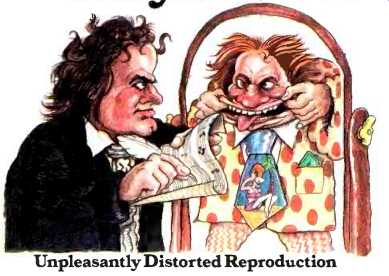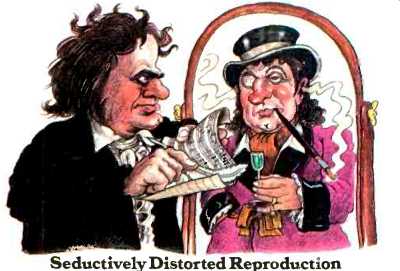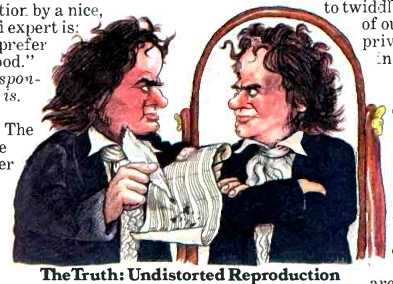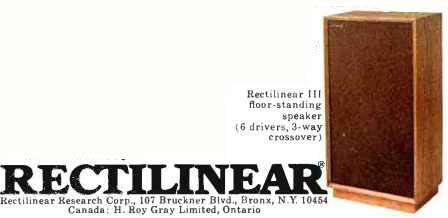When two loudspeakers sound different, at least one of them is wrong. Maybe both.

---Unpleasantly Distorted Reproduction
Which is better: the Rectilinear III, at $299, or a comparably priced but totally different-sounding speaker by another reputable manufacturer? The ready answer to that question by a nice, clean-living salesman or boy-scout hi-fi expert is: "It's a matter of taste. Whichever you prefer for your own listening. They're both good."
We want you to know how irresponsible and misleading such bland advice is.
Think about it:
A loudspeaker is a reproducer. The most important part of that word is the prefix re, meaning again. A loudspeaker produces again something that has already been produced once.
Not something new and different.
Therefore, what it correctly reproduces should be identical to the original production. And identicalness
isn't a matter of taste For example, it isn't a matter of taste whether the body shop has correctly reproduced the original color of your car on that repainted fender. Nor is it a matter of taste whether your mirror correctly reproduces your visual image. Is the reproduction identical to the original or isn't it?

----------Seductively Distorted Reproduction
Okay. We know. The ear is less precise than the eye. And in the case of loudspeakers, it's usually impossible to compare the reproduction and the live original side by side. Furthermore, the speaker is only a single link in a whole chain of reproducers. But these problems only complicate the matter without changing the basic principle. The reproduction is either right or wrong. Two different-sounding reproductions can't both be identical to the original.
The common fallacy is to call the reproduction wrong only when it's obviously unpleasant ( fuzzy or shrieky highs, hollow midrange, etc.). But what about a pleasingly plump bass, lots of sheen on the high end, and that punchy or zippy overall quality known as "presence"? Equally wrong. And, because of the seductive "hi-fi" appeal, much more treacherous.
To glamorize the original that way amounts to having a built-in and permanently set tone control in your speaker. For some program material it can be disastrously unsuitable. Like the funhouse mirror that makes everybody look tall and thin, it's great for short and fat inputs only.
At Rectilinear, we design speakers to approach facsimile reproduction of the input as closely as is technologically possible. We restrict the "taste" factor to twiddling the tone controls of our amplifier in the privacy of our home. Not in our laboratory.

----------The Truth: Undistorted Reproduction
The Rectilinear III is our best effort to date in this direction.
And our inspiration for it was a totally different and rather impractical design: the full-range electrostatic speaker.
Any serious audio engineer will tell you that electrostatics are inherently superior o conventional speakers in producing an output that's identical to the input. This superiority is due to scientifically verifiable characteristics, such as flatness of frequency response and low time delay distortion.
The trouble is that electrostatics create tremendous problems with amplifiers, have difficulty playing really loud without distortion and are also somewhat deficient in bass. But-they're accurate, undistorted "mirrors" of sound.
The Rectilinear III is the first successful attempt to give you this electrostatic type of sound in conventional speaker without any of the above problems.
It allows you to hear what composers, musicians and record producers have created for you and not what some speaker manufacturer thinks will please you.
So, next time you're in a store and you hear another $299 speaker that sounds different from ours, you'll have an idea which of the two is wrong. And which is the one to buy.

----------Rectilinear floor-standing speaker (6 driver 3-way crossover, )
RECTILINEAR
Rectilinear Research Corp., 107 Bruckner Blvd., Bronx, N.Y. 10954
Canada: H. Roy Gray Limited, Ontario
(adapted from Audio magazine, Dec. 1973)
Also see:
Rectilinear 5 loudspeaker (Oct. 1975)
Rectilinear XIa Loudspeaker System (Equip. Profile, Aug. 1973)
Rectilinear Research Corp. loudspeakers (ad, Oct. 1973)
= = = =